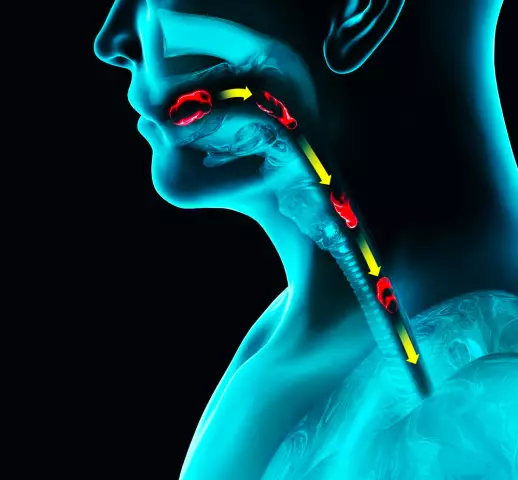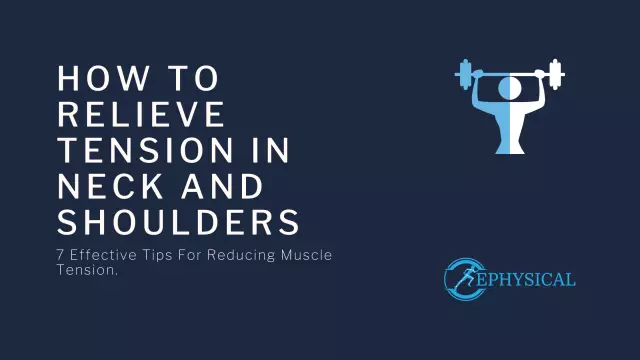- Author Rachel Wainwright [email protected].
- Public 2023-12-15 07:39.
- Last modified 2025-11-02 20:14.
How to relieve esophageal spasm

According to statistics, esophageal spasm most often occurs in women between the ages of 18 and 35. The percentage of men and women suffering from this disease is equal to 45 years. Spastic syndrome is expressed in the inability to swallow food and is accompanied by pain in the chest. A visit to a doctor, as a rule, occurs only in the case of severe pain.
Symptoms of esophageal spasm
Symptoms of esophageal spasm include dysphagia, as well as pain in the chest and between the shoulder blades, which occurs during exertion and can radiate to the back, arms, ears, and lower jaw. The pain lasts from a few seconds to an hour and can be pulling, burning, or cutting. It is sometimes confused with heart pain. Dysphagia can occur regardless of pain. It becomes difficult to swallow not only solid, but also liquid food, as well as saliva.
The causes of esophageal spasm and the symptoms accompanying it are mainly associated with disorders in the nervous system, but they can also have another origin:
- Improper nutrition;
- Insufficient grinding of food with teeth;
- Microtrauma when small bones get inside;
- Burns of the mucous membrane with strong alcoholic beverages;
- Foreign body jam;
- Inflammation of the organs located near the esophagus;
- Intercostal neuralgia;
- Infection;
- Meningoencephalitis;
- Stress.
With a spasm of the esophagus, an involuntary contraction of its smooth muscles occurs. Depending on the nature of the origin of the spasm, two types are distinguished:
- Idiopathic (primary) - caused by organic changes in the nervous system;
- Reflex (secondary) - caused by inflammation of the esophageal mucosa.
Inflammation of the mucous membrane occurs with gastric and duodenal ulcers, hernia of the alimentary opening of the diaphragm, gallstone disease and esophagitis. Violation of the motor functions of the muscles is also possible due to the regular reflux of gastric contents into the esophagus in gastroesophageal reflux disease. In addition, reflex esophagospasm can develop after poisoning or vagotomy, as well as against the background of diabetic neuropathy, vascular collagenosis and some connective tissue diseases. There are frequent cases of esophageal spasm after nervous disorders and strong psychoemotional shocks.
Varieties of esophageal spasms
Depending on the nature of the dysfunction of smooth muscles, two types of esophageal spasm are distinguished:
- With segmental spasm, the muscles contract strongly in a certain area;
- With diffuse esophageal spasm, the work of the muscles is uncoordinated throughout the organ.
The spasm occurs at the entrance or at the end of the esophagus, in the area of the sphincters. These areas are laced with nerve endings and therefore are the first to react to malfunctions of the nervous system.
Segmental or acute esophagus spasm develops if the amplitude of contraction of the esophageal muscles is twice the normal value. This violation does not progress and does not lead to serious consequences. The diagnosis is established using manometry. With segmental spasm of the esophagus, treatment is first medication. Prescribe calcium channel blockers, as well as sedatives, especially with pronounced psychological components of the disease. The frequency of pain attacks may decrease after psychotherapy sessions. Myotomy is recommended only in severe cases, since muscle dissection can lead to various complications.
Diffuse esophageal spasm is characterized by deterioration of motility while maintaining the normal tone of the lower sphincter. The essence of diffuse esophagospasm lies in the repetitive strong contractions of the muscles in the middle and lower parts of the esophagus from time to time. As an independent disease, this type of spasm can be diagnosed only in the absence of other disorders. The pathogenesis of diffuse spasm is not well understood. It is believed that spastic attacks are caused by disorders of the nervous autonomic innervation of the esophagus, which arise as a result of functional failures of the nervous system and stress.
Therapy of diffuse esophageal spasm is carried out as an ambulance by intravenous or intramuscular atropine. This method also serves as a diagnostic test. The functional nature of the esophageal obstruction is established if the spasm disappears one hour after the injection of atropine and resumes two hours later.
Treatment of esophageal spasm
With idiopathic esophageal spasm, conservative methods, as a rule, are not able to eliminate the cause of its occurrence, therefore, drug prevention is carried out. With reflex esophagospasm, a disease that provokes a violation of the functions of smooth muscles is treated.
Medication includes calcium channel blockers and nitrates. They have a moderate spasmolytic effect on the walls and lower sphincter of the esophagus. Also shown are anticholinergics and, in some cases, prokinetics or antacids. In case of esophageal spasm due to nervous shocks and mental trauma, sedatives and antidepressants are prescribed, with the help of which pain and anxiety are relieved. Explaining the essence of the disease and convincing the patient that there is no cancer or coronary heart disease relieves him of fear and reduces the likelihood of spasm.
To normalize the functioning of the nervous system, a course of physiotherapeutic procedures is prescribed, which includes:
- Electrophoresis of calcium chloride, magnesium sulfate or novocaine on sympathetic nerve nodes in the neck;
- Galvanization of the collar zone according to Shcherbak.
If conservative treatment of esophageal spasms does not help, then surgery is required. In particular, the opening of the esophagus is enlarged using a steel probe. The operation takes place under the control of X-ray equipment. Full recovery may require several sessions in conjunction with anti-inflammatory therapy to avoid the development of a chronic disorder.

Of great importance in therapy is a special diet, in which the following are completely excluded from the diet:
- Alcohol;
- Sparkling water;
- Too cold and hot food;
- Fatty, spicy and fried foods;
- Coarse fiber;
- Pastry products;
- Fresh bread;
- Strong fish and meat broths;
- Pork;
- Lamb;
- Hot spices and herbs.
You can eat a little every 3-4 hours. It is important to take your time and chew your food thoroughly.
The effectiveness of folk methods for esophageal spasms is based on the fact that the components of the decoctions have antispasmodic, anti-inflammatory and sedative properties. Consultation with your doctor about the use of these products is imperative, as some herbs cannot be mixed or consumed at the same time. In addition, decoctions and tinctures can be taken only if their temperature does not exceed 40 ° C. It must be remembered that esophagospasm can be caused not only by stress, but also by quite serious diseases in which traditional medicine is powerless.
Found a mistake in the text? Select it and press Ctrl + Enter.






